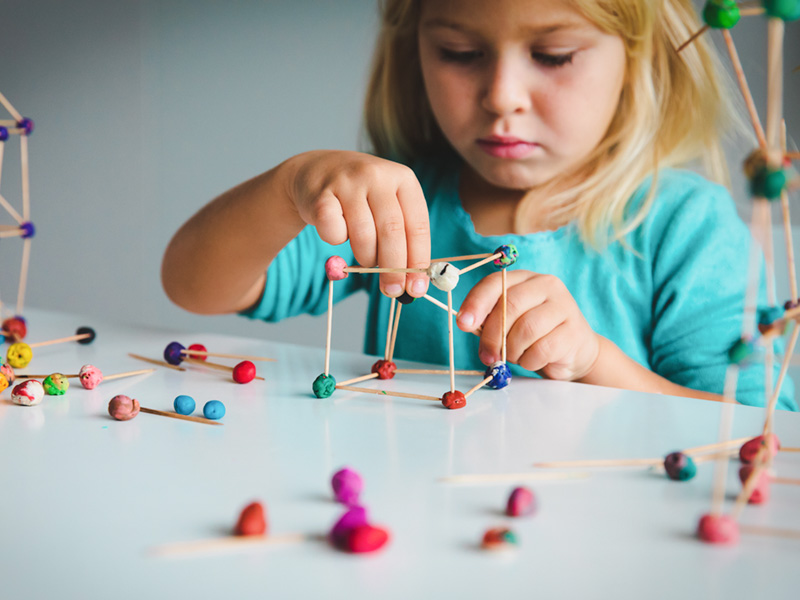STEAM Activities for Preschoolers
Do your children have an interest in figuring out how things work? Do they enjoy experimenting with their surroundings? You may have a budding engineer, astronaut, mathematician, artist or scientist on your hands. Even kids who are not naturally drawn to all things math and science enjoy exploring their environment and figuring out how they work. STEAM, which stands for Science, Technology, Engineering, Art and Math, are activities that engage kids of all ages in these specific areas.
According to the U.S. Department of Commerce, STEM (Science, Technology, Engineering and Math) occupations are growing 17% per year, and STEM degree holders have a higher income. While a career in the STEM field may seem like a long way off for your preschooler, STEM education creates critical thinkers, increases science literacy and enables innovation of new products in the future. Most would agree that jobs of the future will require a basic understanding of math, science and technology, and it is never too early to start developing your child’s interest in these areas. While many schools are developing STEAM curricula for classrooms, there are plenty of things you can do at home to kick-start your preschooler’s love of science and art.
In the kitchen
Your school teachers were right: you do use math and science in everyday life. You may already love cooking with your kids, but consider incorporating science and math lessons at the same time. While baking cookies, have your children help measure the ingredients, count the scoops of flour, talk about what happens if you do not use the correct measurements and discuss what the purposes of baking powder and baking soda are. (They leaven the batter to rise while baking.) Make the experience fun and educational at the same time. Your child may not even notice they are learning about math and science while baking and sampling tasty treats. Add in some art and let your kids decorate your desserts.
DIY science lab
Create your own science lab mixing station at home. All you need is several plastic or glass containers (see-through are best) of any shape and size. Fill containers with dry ingredients such as baking soda, baking powder, salt, sugar and cornstarch. Fill additional containers with wet ingredients such as water, white vinegar, lemon juice and ice. It may be wise to lay towels underneath your mixing station or set the ingredients up outside so you can have fun without worrying about the difficulty of cleanup. Once your science lab is set up, it’s time to get creative. Let your kids experiment with what happens when different ingredients are mixed. This activity is great for preschoolers but can also be adopted to older children by providing them with a journal to record the results of each combination of ingredients when they are mixed.
Use what you have
Set up a sensory bin using dried beans, water beads or rice as a filler, then hide items inside. Ask your child to find the red dinosaur, count the green items or close their eyes and guess what items they feel. Encourage your little engineer or architect to build a tower using toothpicks and marshmallows or fill a tray with shaving cream and blocks and ask if they think the shaving cream will help their blocks stick together. Sharpen their math skills with colored cereal like Froot Loops. Ask your child to sort the pieces by color and count them. Then have them string the cereal on yarn to make a necklace. Make it fun and see what potential STEAM activities you have laying around the house.
Preschoolers love to explore with their hands and all of their senses, which makes the possibilities endless. Go outside, point out the colors and have the kids draw what they see. Plant a garden, fill water glasses with food coloring and mix to learn about colors, count and sort items throughout the day, talk about and chart the weather or play with magnets and a cookie sheet. STEAM is all around us just waiting to be explored.
Express Yourself
Make sure your toddlers have materials to express themselves. Give them crayons and lots of paper to experiment with. Include painting supplies, as well as clay, glue, old magazines and even a sketch book. And don’t forget about performing arts. Encourage pretend play with old clothes and accessories. Have them create hand puppets and put on a puppet show. Also, encourage your little ones to sing and dance. Purchase rhythm instruments they can experiment with or have them create instruments with simple household materials.
Related
Summer Science Experiments to Try at Home
STEAM Projects for Steamy Summer Days
Empowering Girls in the Field of STEM

